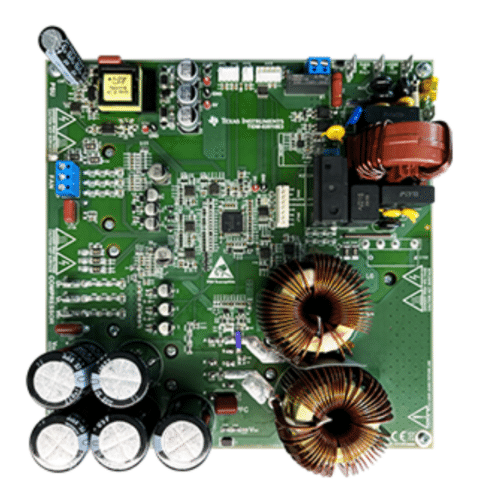The design integrates dual motor drives and PFC control, which makes it suitable for various HVAC applications, including air conditioning, refrigeration, and laundry appliances.

In the rapidly evolving landscape of HVAC technology, there’s a pressing need for systems that provide enhanced comfort and greater power and prioritise affordability, compactness, and high energy efficiency. Addressing these multifaceted demands, the Permanent Magnet Synchronous Motor (PMSM) is emerging as a preferred choice over traditional induction motors. This shift signifies a critical step towards meeting modern HVAC requirements, reflecting an industry-wide commitment to innovation and sustainable development.
The TIDM-02010 reference design by Texas Instruments (TI) is a versatile and comprehensive solution tailored for HVAC applications, particularly for variable-frequency outdoor air conditioner units. The design integrates a dual motor drive and Power Factor Correction (PFC) control system, featuring a sensorless 3-phase Permanent Magnet Synchronous Motor (PMSM) vector control for both compressor and fan motors and a digital integrated boost PFC. Operating within a voltage input range of 165 V to 265 VAC, it is compatible with 50/60 Hz power systems and meets new efficiency standards using a single C2000 microcontroller.
The inverter stages are designed to handle up to 1.5 kW for the compressor and up to 150 W for the fan, with 6 and 18 kHz switching frequencies. The design includes advanced features like torque compensation, automatic field weakening control, stall detection, auto recovery, flying start, and overcurrent protections. The PFC part of the design operates at a 72 kHz switching frequency, achieving a power factor greater than 0.95 and less than 5% Total Harmonic Distortion (THD) over the entire operating voltage range.
Beyond air conditioning, this design is adaptable for refrigerators, freezers, washers, dryers, and appliance compressors, enhancing efficiency and performance. It simplifies the coordination of dual motor applications. It includes additional functionalities such as serial communication with indoor units, a stepper motor drive for electronic expansion valves, and temperature sensors for comprehensive system control. The accompanying hardware and software are ready to use, significantly accelerating development and market introduction.
The system comprises seven integral blocks, each playing a crucial role in its overall functionality. These include a digital active EMI filter, which minimises electromagnetic interference, and a digital integrated PFC (power factor correction) for efficient power management. The system also features two separate 3-phase inverters, one for Motor_1 (Compressor) and another for Motor_2 (Fan), ensuring optimal control and efficiency for each motor. At the heart of the system lies the MCU Controller, which orchestrates the operation of all components. Additionally, a Valve and Relay Drive is dedicated to system control, providing the necessary mechanisms for regulating various system functions. Lastly, the Auxiliary Power Supply ensures all components receive the power required to function effectively.
TI has tested this reference design. It comes with a Bill of Material (BOM), Gerber file, PCB layout, schematics, etc. You can find additional data about the reference design on the company’s website. To read more about this reference design, click here.






